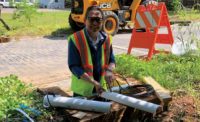The son of a pioneer bush pilot in Alaska, structural engineer John Aho spent decades working toward earthquake preparedness. He helped found a key seismic safety commission in the state, and serves on the City of Anchorage’s geotechnical advisory group. The fruits of his labor were clearly demonstrated on the morning of Nov. 30, when the magnitudes 7.0 and 5.7 earthquakes that struck the city caused limited structural damage, partly due to stringent building requirements.
Aho also played a vital role in securing funding for Anchorage’s dense network of strong-motion seismometers, most of them installed by 2002. “We were trudging around Washington, D.C., in 100˚ heat trying to convince congressional reps and senators to fund this network,” says John Filson, scientist emeritus with the U. S. Geological Survey.
Aho also worked with building owners to allow the sensors’ installation and helped raise additional private money to fund the 50-sensor network. The instruments recorded massive amounts of data during the Nov. 30 quake, and officials are working to present this data at a technical conference this year.
A now-retired former vice president and principal project manager at CH2M, Aho spent 30 years working to establish the Alaska Seismic Hazards Safety Commission, launched in 2002, and served as the group’s chairman. He holds a PhD in aerospace engineering from Cornell University, but slim job prospects in that field in the early 1970s shifted his energies to seismic resilience.
Aho was also an instructor for earthquake mitigation and post-earthquake safety evaluation, training many of the experts who investigated damage from the recent temblor. He still serves on Anchorage’s Geotechnical Advisory Commission, which helps write local amendments to strengthen the International Building Code. The group also works to ensure seismic resilience in new development. Aho points to the limited quake damage to the 1996 Nesbett Courthouse, built on a bluff atop precarious soil, as an example of the group’s effectiveness.
“All this stuff is really a fight, because earthquakes of the size we felt don’t occur every day, so people are more interested in fixing the roads and less interested in phenomena that could occur in 100 years or maybe tomorrow,” he says.




Post a comment to this article
Report Abusive Comment